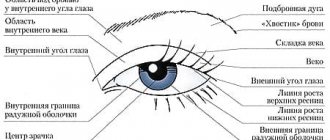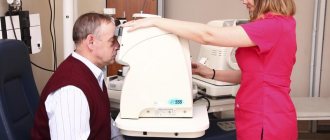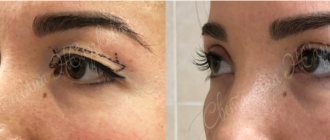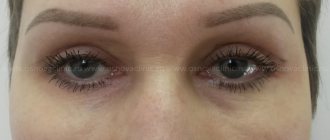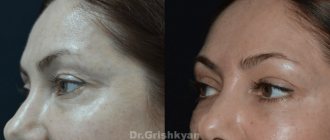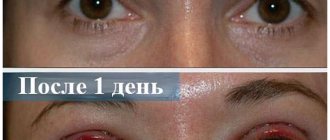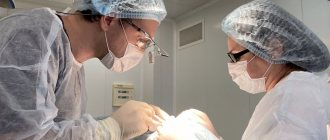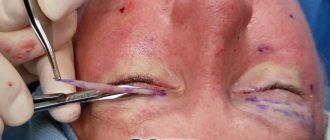Any plastic surgery is a complex procedure, and in each specific case the body may react differently to the intervention. Blepharoplasty is one of the most delicate and complex operations, since the surgeon must not only correct existing age-related changes in the eyelids, but also ensure the aesthetic appearance of the periorbital area without disturbing the aesthetic proportions of the face.
Unsuccessfully performed blepharoplasty can change the face beyond recognition, give the look a sad look, change the shape and shape of the eyes. It must be said that it is often very difficult to correct the changes that have arisen and this requires a number of reconstructive operations.
So what are the signs that indicate unsuccessful blepharoplasty:
- Noticeable scars (high on the upper eyelids and low on the lower eyelids)
- Failure to close eyelids due to deficiency of upper eyelid skin (short upper eyelids)
- Ectropion (shortening of the lower eyelid), the appearance of a strip of sclera under the iris
- Dry eyes, watery eyes
- Eversion of the lower eyelid
- Appearance of scar epicanthus at the inner corner of the upper eyelid
- Presence of residual “hernias” of the eyelids
- Deformation of the shape and size of the palpebral fissure (“round” eye)
Causes of ptosis
Blepharoptosis of the eyelids has a number of different causes. For example, in some people, ptosis of the upper eyelids is exacerbated by drooping skin on the forehead and eyebrows. This ptosis persists months after plastic surgery and is corrected by tightening the skin in the frontal area and at the eyebrow level.
In other cases, at the stage of skin healing after surgery, blepharoptosis is considered a natural phenomenon. It occurs when there is excessive swelling of injured tissues or hematomas formed during the rehabilitation period. And sometimes the reason for the drooping of the upper eyelid may lie in the muscle that is mistakenly touched during surgical procedures, which is responsible for raising the upper eyelid. Thus, depending on the cause of the development of the defect, several types of ptosis of the upper eyelid are distinguished.
“ROUND EYES” EFFECT
The most common mistake that an inexperienced surgeon can make when performing blepharoplasty is to excise too much skin of the lower eyelid. As a result, the so-called “round eye effect” occurs: the eyes look unnaturally bulging, and in the worst case, they do not even close completely. Needless to say, such an effect not only completely spoils the impression of the operation, but also significantly complicates the patient’s life.
Such patients develop watery eyes, dryness and redness of the eyes, and conjunctivitis often occurs. The eyes have an unnatural, “operated” appearance.
Types of postoperative blepharoptosis of the eyelids
Ptosis of the upper eyelid after blepharoplasty is usually divided into varieties according to the following categories:
- According to the degree of eye damage: I degree - the eyelid covers only 1/3 of the pupil; II degree - it drops to the middle of the pupil; III degree - completely covers the pupil.
- By prevalence - unilateral (on one eye) or bilateral (detected in both eyes at once).
- According to the source of occurrence - neurogenic, mechanical, aponeurotic, myogenic and pseudoptosis.
Neurogenic drooping of the upper eyelid is understood as a pathology that appears after suffering serious illnesses (injuries, in particular, to the brain). Mechanical ptosis is a distortion of the eyelid caused by the entry of a foreign body into the eye cavity, as well as injury, and the formation of a specific scar in the form of a scar at the site of injury. Aponeurotic ptosis occurs due to weakening or stretching of the tendon of the upper eyelid muscle. It can occur not only as a result of surgical techniques in the eye area, but also due to human aging.
Myogenic blepharoptosis is a consequence of the inability of the eye muscle to perform its function properly. Pseudoptosis—or “false,” “apparent” drooping of the eyelid—occurs in other eye diseases (such as strabismus, blepharochalasis, or hypotony of the eyeball) and is formed by excess folding of skin on the upper eyelid.
When is revision blepharoplasty required?
Repeated blepharoplasty of the upper or lower eyelids is required in the following cases:
- Hernial sacs formed for the second time. The problem arises if not enough fatty tissue was removed during the first operation.
- Sunken eyes. The defect occurs if too much subcutaneous tissue has been removed from the eyelid area.
- Unaesthetic folds appeared on the eyelids.
- "Round eyes". The defect occurs due to excessive removal of skin tissue or a problem with the orbicularis muscle.
- One eye is larger than the other (asymmetry).
- Changes associated with age.
If the first correction was carried out efficiently and skillfully, then a secondary intervention will be needed only after 5-8 years. Also, the duration of the result depends on the general condition of the body and lifestyle. The effect is reduced in the presence of destructive habits (alcoholism, smoking). Moisturizing complexes, massage, and peeling can prolong the results of plastic surgery.
Symptoms of blepharoptosis of the upper eyelid
It is necessary to understand that blepharoptosis after eye surgery cannot always become a defect and persist for a long time after correction. On the contrary, during the entire rehabilitation period it is considered a normal physiological phenomenon - after all, due to the dissection of tissues and the subsequent application of sutures to them, profuse swelling is detected. It causes the sagging of the upper eyelid, which increases in size and becomes heavier, and therefore slides down to the border of visibility of the eyes.
In general, recovery time does not last longer than three weeks, although it is strictly individual for each patient undergoing rehabilitation.
The following signs can be considered symptoms of blepharoptosis, which has turned into a complication:
- persistence of edema for more than 8 days from the date of surgery;
- progression of the drooping of the upper eyelid (over time it falls lower);
- concomitant lower eyelid inversion;
- the presence of prolonged hematomas or infectious signs (suppuration of sutures).
All these indicators are difficult to miss, and their presence in a person can be determined even from a photo. They can unpredictably affect visual function and provoke the emergence of a number of new pathologies. That is why it is necessary to strictly adhere to the recommendations of the attending physician and, if you suspect the development of complications, consult a specialist in a timely manner.
RESULT OF BLEPHAROPLASTY
Correction of the eyelids instantly transforms the appearance: the look becomes open and youthful, swelling, bags under the eyes, wrinkles, and sagging eyelids disappear. The result of the operation lasts for many years; recommendations for care and consolidation of the effect will be given by specialists from the Cosmetology Department of the N. I. Pirogov Clinic. For a quick recovery, cosmetologists select a program, after which you can quickly enjoy the result of the operation and demonstrate it to others.
Is it necessary to treat blepharoptosis after eyelid blepharoplasty?
As such, there is no medical or therapeutic treatment for postoperative ptosis. However, if it becomes a complication, and its degree increases from I to III, then after 8 days you should contact your attending ophthalmologist.
At the appointment, guided by the data obtained during the examination and history taking, they find out whether ptosis could be a consequence of taking any medications, previous diseases, or the result of heredity. In most cases, blepharoptosis is corrected using a reconstructive surgical method, that is, repeated surgery to eliminate the resulting defect.
Blepharoplasty: prices and reviews
The cost of the operation depends on the scope of correction and the qualifications of the plastic surgeon. Our clinic also has profitable promotions, you can find them in this section
. The cost of lower/upper eyelid blepharoplasty already includes: surgery, anesthesia, stay in the ward, postoperative patient care (examination by a surgeon, dressings and suture removal), consultation with a cosmetologist and one procedure of hardware lymphatic drainage massage
view reviews of blepharoplasty at the Pirogov Clinic
(St. Petersburg) in the corresponding section on our website.
Prevention of ptosis after eyelid correction surgery
In order to reduce the risk of aggravating consequences after eye surgery, including blepharoptosis, it is necessary to adhere to a number of simple recommendations and rules aimed at preventing the development of complications in the recovery period. These requirements are not too complicated.
To prevent the appearance of blephoraptosis after blepharoplasty, you must:
- Sleeping in such a position that your head is always slightly above body level will reduce the likelihood of swelling.
- Use sunglasses while walking.
- Avoid contact with lenses and cosmetics (face and eye care products) and do not take baths or showers for 3-5 days.
- Avoid any physical activity, as well as activities that increase eye strain (reading, watching TV and using computers and phones).
- Stick to a diet and do not abuse salty foods (it delays the resorption of swelling).
- For two weeks, strictly avoid drinking alcoholic beverages and refrain from smoking.
- Use cold compresses, antiseptic drops and ointments, painkillers and anti-inflammatory medications, and perform certain therapeutic exercises prescribed by your doctor.
Any surgical intervention in the area of the upper and lower eyelids requires the highest qualifications of a practicing ophthalmologist. Due to the complexity of the anatomy and the subtlety of the stages of the operation, it is necessary to strictly follow his recommendations. And remember - only an experienced specialist can sensibly assess the condition of the eyelid tissues and rationally choose the method of blepharoplasty.
How is blepharoplasty surgery performed?
Duration of circular blepharoplasty – up to 1.5 hours
.
The operation takes place under local or general anesthesia. The plastic surgeon makes incisions in the natural folds of the skin of the upper eyelid and under the eyelash line (when correcting the lower eyelids). This provides access to the subcutaneous fatty tissue. After removing excess skin and fat, the surgeon applies stitches and a special bandage, which is removed 30 minutes after the operation. The length of hospitalization
after blepharoplasty ranges from 6 hours (in a day hospital) to 1 day in a ward, after which we discharge patients home.
Why might the operation fail?
Unfortunately, the most common reason for a failed operation is insufficient qualifications or mistakes by the surgeon. Therefore, we recommend that you approach the choice of the doctor who will perform the operation as carefully as possible. This must be an experienced surgeon who has had a sufficient number of successful operations in this area. The clinic where blepharoplasty will be performed must have all the necessary modern equipment for eyelid correction.
Remember that proper preparation for surgery and compliance with all doctor’s recommendations is the key to successful correction!
However, you should not place all responsibility for the result of the operation on the plastic surgeon alone. Most complications depend on the individual characteristics of the patient’s body.
Preparation
If the result is unsatisfactory, repeat blepharoplasty of the upper or lower eyelids can be performed after complete tissue healing and scar formation. Usually the correction is done one year after the first operation. Careful preparation is required before the procedure. The patient undergoes a standard medical examination, based on the results of which the doctor diagnoses possible complications, their degree and type. You also need to give up smoking, alcohol and medications that can cause bleeding. The day before the procedure, you should not use eye creams.
The repeated corrective procedure is carried out longer than the first one and under anesthesia. Treatment tactics are determined according to the patient’s indications and traumatic techniques. The skin is cut along the original scars and their excision is carried out.
